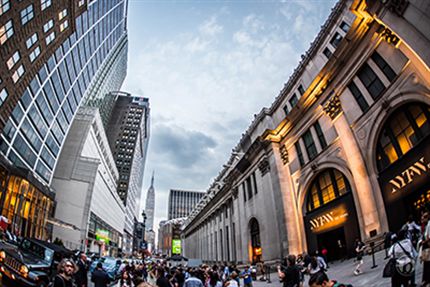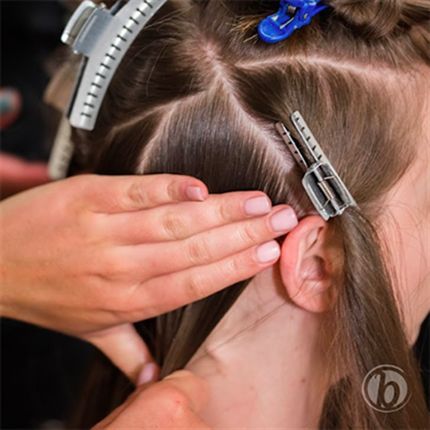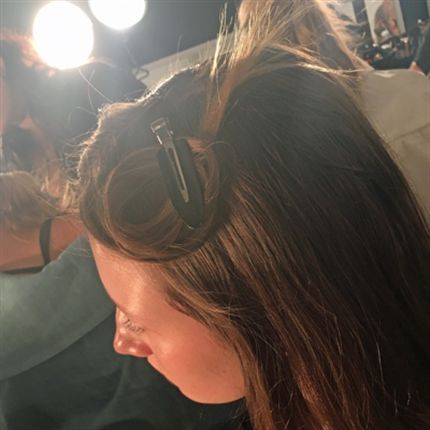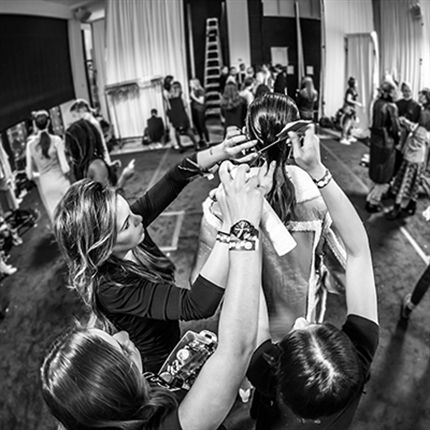15 Hair Cheats Straight From New York Fashion Week
You’ve seen The Devil Wears Prada, right? So you know Miranda Priestley’s famous speech about how ~fashion~ works—what we see on the runway and in editorial spreads now will inform the major trends in clothing, hair and makeup over the next year. That’s why BTC was backstage at New York Fashion Week Spring/Summer 2017. We were in the trenches, walking through clouds of hairspray, dodging half-naked models and running from show to show to get you a close-up look at what’s to come in the next season AND to grab the best tricks from the Fashion Week pros.

A fisheye view of the NYFW headquarters.
1. When There’s Too Much Hair
When a designer wants models to have minimal volume, it can be hard to achieve on girls with a lot of hair. So conceal it! Lead stylist Jon Reyman for Aveda created a small ponytail in the back and under the hair at the HELLESSY show, and Paul Hanlon for Moroccanoil® gave his thick-haired girls a small braid underneath to reduce volume at the Vera Wang show. These two techniques help hide the bulk and give the finished look a lighter feel.
2. Next Year’s Festival Hair Ideas!
The clothes at Jonathan Simkhai were very Coachella—think a girl that parties all day in the desert, then goes to lay poolside somewhere glam. Thomas Osborn, TIGI® U.S. Creative Director, used a ton of CATWALK by TIGI® Texturising Salt Spray before rough-drying models’ hair, then wrapped large sections around a 1.5-inch iron without closing the clamp. Then take a flat iron to random sections to give it a “just walked through the desert” look. The final touch? Skinny, sporadic braids wrapped with embroidery floss. We also LOVED this macramé-inspired bun at Ryan Roche by James Pecis, who used John Paul Mitchell Systems Awapuhi Wild Ginger products. The look was ballerina-inspired, but with a tough edge. We predict this will be quite a trend on the 2017 music festival scene.
3. Keep Your Ponies In Shape
A ponytail is never just a ponytail, and this was never more true than at Fashion Week. To keep the ponies at Taoray Wang from sagging into post-spin class territory, Rodney Cutler for Ulta Beauty and Redken created his ponytails in sections. Smooth the top section into the pony where you want the base to be, then secure. Grab the section below and smooth the sides nicely, then add that to the existing pony. Finally, take the bottom section and do the same. That keeps the sides tight and sleek and elevates the simple ponytail into something special.

The twisted chignon at Taoray Wang by Rodney Cutler for Ulta Beauty and Redken was meant to be soft and strong, just like the feminine-meets-masculine clothes.
4. You Don’t Always Have to Follow The Product Instructions!
It’s OK to use products for different purposes than they’re intended—we saw that happening everywhere! For example, Aveda Global Director Antoinette Beenders used Aveda Thickening Tonic on almost every model she styled for Tome (and for this show, the designers used models ages 16 to 70, so there was a LOT of variety!)—and she used it as a finisher instead of a pre-styling product. It gave the hair a lovely softness and amped up everyone’s natural texture. At Vera Wang, lead stylist Paul Hanlon used Moroccanoil® Heat Styling Protection (normally used before blow-drying) as a finishing product to give models lived-in movement and separation.
5. Don’t Be Afraid of Product
Something that might surprise Fashion Week newcomers is the sheer amount of product used on each model’s head. At the Brandon Maxwell show, we saw James Pecis and other Oribe artists putting models’ hair up in polished ponies—but they were using Maximista Thickening Spray in sections, then smoothing tightly and adding to the pony to keep it tight, tight, tight and avoid any bubbles in the finished look.
6. It’s Not Just a Ponytail
For International Director of Macadamia Professional and celeb stylist Giannandrea, creating the perfect waterfall ponytail was a much more complex task than you might think. The hair was thick and long and the goal was to have it completely on the top of the head without falling. Giannandrea said to do this, the model (or your client) must lean forward with their head down. If you work from the back or the middle the hair will fall (it’s just the way gravity works!) Another secret? The Macadamia Professional Flex Hold Hairspray is always an essential for this style.
7. Big (Braided) Volume
Vivienne Mackinder is a total pro when it comes to working backstage at Fashion Week. So she knows a trick or two when it comes to getting the hair to do what she wants, and her latest secret at Malan Breton for Joico totally blew our minds. In the photo below, you’ll see a twisted ponytail with sky-high volume on the crown of the head. What you won’t see is the braid hidden under all the volume. Vivienne told her team to create a braid underneath the teased section to get the hair even more voluminous.
8. Get the Coolest Texture
At some shows, designers craved kinked, spiraled or coiled hair—but of course, not all models can deliver those locks. Jorge Luis created texture at the Son Jung Wan show by prepping models with L’ANZA Healing Haircare Keratin Oil, then wrapping sections around a chopstick and applying heat with a flat iron. Once unraveled, they had Donna Summer-inspired curls for DAYS. We also spotted a “fringing” technique by Tina Outen for Bumble and bumble. at the Ji Oh show—she wrapped the hair around a hair pin (only from the midlengths to the ends), then flat-ironed the pins for those messy, kinky bends. Check it out in the quick video below!
9. Ask For Help!
One of our favorite Fashion Week tips didn’t happen at Fashion Week this time around, but still comes from a Fashion Week pro and we just had to share! Editorial Stylist Orlando Pita filled us in on a little backstage secret while we were at the PHYTO Academy in NYC: don’t be afraid to ask your client or model for help when working on a complicated style! “I’ve asked girls to help me hold the braid so it didn’t move as I worked,” he revealed.
10. Change The Part, Change The Look
From the zigzag to the deep side, partings throughout any style can instantly and drastically change the look and feel of your client (or model’s!) hair. This style focused on hard parts that created triangle sections throughout the head, but try pulling the hair back with less product, then add a fun zigzag to the side of the head—all of a sudden teenagers everywhere will be rocking it. “I don’t think people always remember they can add a part…but when you do, it can change the whole look,” said Lisa Lobosco for ECRU New York at Daniel Silverstain.

Lisa and her team were creating a geometric style…
so hard parts were necessary!
11. You Don’t Have to Move to NYC
A lot of aspiring editorial stylists think the only way to get noticed and start working at the editorial level is to pack their bags and move to a big city. Lead stylist Michiko Boorberg at Desani Hoffman for Alterna Haircare doesn’t fully agree. “You don’t have to move right away,” she said. “You can go for a long weekend, work, get your name out there and then go back home.” For Michiko, building a portfolio is how to get to that next level, and she wants stylists to know they can do that by hopping on a plane for a few days before making a permanent move.
12. Natural Texture Smoothing Secret
We caught up with Aveda’s Allen Ruiz backstage at Tibi where he showed us a technique to smooth natural texture quickly! Check it out.
13. It’s ALWAYS All In The Details
The tiny touches MAKE the hair at Fashion Week. Bumble and bumble Global Artistic Director Laurent Philippon added a grosgrain ribbon to the sleek, low ponytails at Mansur Gavriel, simply wrapping it twice and securing with double-sided tape. “It’s minimal and elegant,” he said. “It’s a little detail I like very much.”
14. The Natural Look is Going To Be HUGE
Everywhere we went, natural, effortless-looking hair was THE style. It conveys a sense of “I’m too cool to care.” But even though it LOOKS effortless, it definitely takes a lot of work! The hair at Prabal Gurung is one example. Anthony Turner used ColorProof Evolved Color Care IronMaster Color and Heat Protecting Setting Spray on freshly washed hair, then blow-dried with his hands, using his fingers to give the hair random bends. He then took the front pieces and looped them up with a clip to let them set—the key to that “cool girl” bend.

At Prabal Gurung, Anthony Turner wanted just a little wave in the front pieces of hair, so he pinned them up and let them set while models had their makeup done.
15. Pay Attention to the Fabric
When deciding on the hairstyles they will create for the runway, many hairdressers choose looks that complement and reflect the fabrics used in the clothing. For example, Paul chose a smooth, all-down look to complement the sleek, dark fabrics at Vera Wang. Ruffled, fringed, textured clothing as seen at Ji Oh translated to wavy, textured hair.
Need more NYFW?! Check out
our Facebook album & see all the coverage!








